Wearing khaki as you watch a tiger stalk a jackal. Hunting for mummies, nuggets of gold, and sparkling cubic zirconia.
Wishing for a cushy job as a millionaire mogul. Doing a magic trick.
Pouring coffee from a carafe into a demitasse. Sipping a mint julep while eating a spinach kabob with pistachio-studded naan bread. Enjoying the fragrance of musk, tulip, jasmine, orange, lilac, or lemon.
What could these bizarre and disparate activities possibly have in common?
They’re all described using words that come from Persian.
The Persian language is called Farsi in the Persian language. Throughout this post the two names are used interchangeably.
Learn Farsi history, grammar, and script, explore resources, guides, and tips. Is Farsi easy to learn? What’s the best and easiest way to learn Farsi? Find out here.
- About the Persian Language
- Is Farsi Easy to Learn?
- What's the Best Way to Learn Persian?
- What's the Easiest Way to Learn Persian?
- How Long Does it Take to Learn Persian?
- How to Learn Persian Fast?
- How to Speak Farsi?
- Your Study Plan for Learning Persian
- Additional Persian Learning Resources
- Books and Literature
While many of these words took a long and winding road from Persian into English, they’ve still attuned your ears to faint echoes of Persian sounds and meanings.
If you’re now hearing those echoes as strong urgings to learn this rich, poetic language, get ready to join a کاروان (caravan) of learners on an extraordinary journey to Persian fluency.
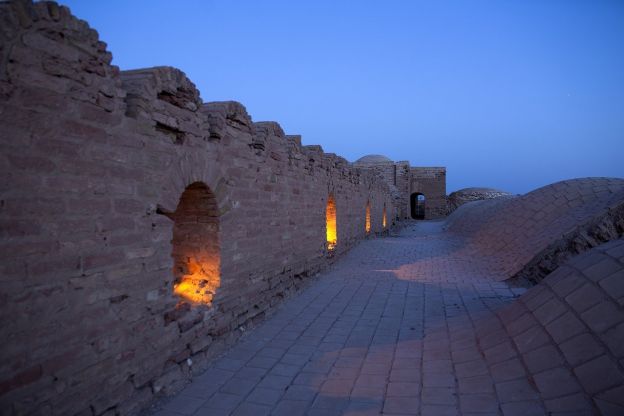
A Caravansarai monument in Iran
We’ll take a brief look at the history and standard forms of the Persian language. Then we’ll formulate a study plan that fits your learning goals and your life. Lastly, we’ll tour the many varied resources you can use to travel from beginning Persian studies all the way up to an advanced level.
About the Persian Language
Rising up from the Persian Plateau over two dozen centuries ago, the Persian language still expresses the thoughts, feelings, hopes, and dreams of over seventy million native speakers in Iran, Afghanistan, Pakistan, and Tajikistan.
Modern Persian is an Indo-Iranian language that traces its roots all the way back to Old Persian, the language used by the Achaemenid Empire under Cyrus the Great (550-330 BC). Its writings date as far back as classical Greek and Latin literature.
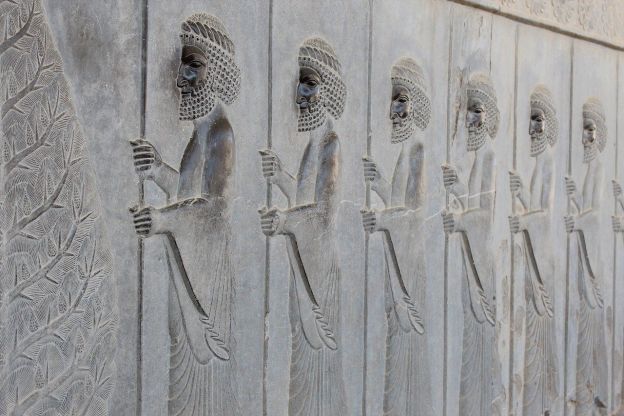
Persepolis, Shiraz, Iran
Persian has long been a language of literature and culture throughout Central, Western, and South Asia, as a result of Persian influences in those areas.
Like Chinese, Persian is considered a macrolanguage, meaning that it encompasses a group of closely related languages. Unlike the Chinese macrolanguage, the individual languages comprising Persian are somewhat mutually intelligible — although there are some differences in pronunciation and vocabulary. The main division in the Persian macrolanguage is between Western and Eastern Persian.
Persian is an official language in Iran, Afghanistan, and Tajikistan. These are also the three countries where it’s primarily spoken. Throughout the globe, there are major populations of Persian speakers in cosmopolitan cities such as Los Angeles (and its “Tehrangeles” community) and London.
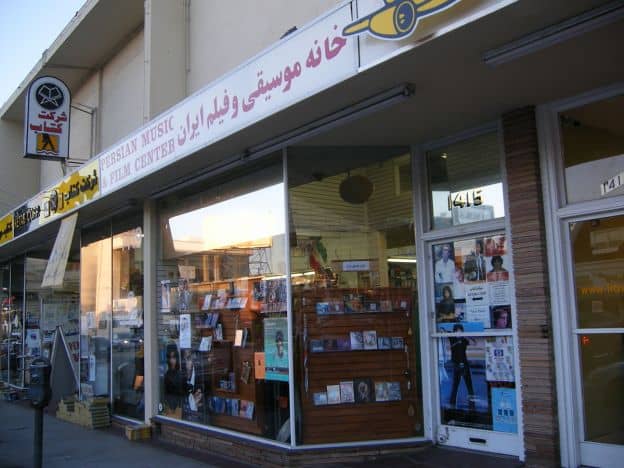
Persian media store in “Little Persia” / “Tehrangeles,” Westwood Boulevard, Los Angeles (Image Credit: Arspickles17, Public domain, via Wikimedia Commons)
In Iran, Persian is called Farsi — a word which derives from the same root as “Persia,” an older name for Iran. A little over half of the Iranian population speaks Farsi as a native language, many of them using the Tehrani dialect that differs somewhat from literary standard Persian. (The other half of the population speaks Azerbaijani, Kurdish, and a handful of other recognized regional languages, such as Arabic and Balochi.) Farsi is considered Western Persian. Many Persian speakers across the world call their language Farsi, even if they (or their ancestors) don’t come from Iran.
The three main Afghan Persian dialects are Dari, Aimaqi (named for the Aimaq people), and Hazagari (the language of the Hazara people). The proper name of the Persian standard used in Afghanistan has been a matter of some debate. Persian — called “Dari” by the government — serves as one of Afghanistan’s two official languages, with the other being Pashto. However, some speakers refer to their language as Fārsī-ye Darī, or simply Farsi. And this is understandable, as Dari and Farsi are similar to each other in many ways.
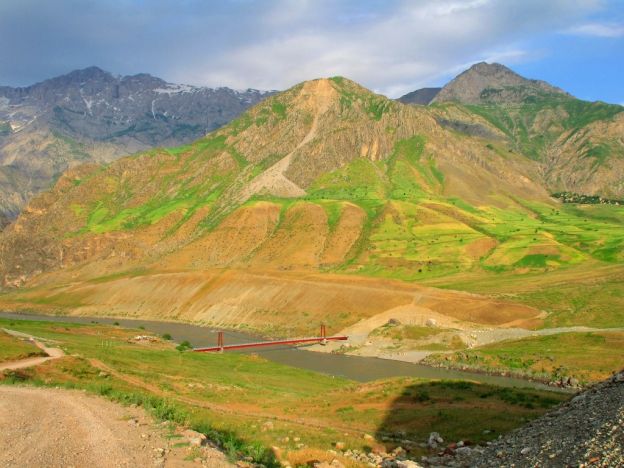
Friendship Bridge spanning the Panj River between Afghanistan and Tajikistan (Image Credit: Khwahan, CC BY-SA 3.0, via Wikimedia Commons)
In Tajikistan, Persian is called тоҷикӣ́ (Tajiki) or Tajik (sometimes spelled “Tadzhik”). The language intermixes Russian and Uzbek loanwords with its Southwestern Iranian roots. It’s also retained many archaic Persian words, similarly to how Acadian French still uses words now obsolete in Metropolitan French. Tajiki has about eight million speakers worldwide — along with its own body of literature, which developed independently of the more mainstream Persian traditions. The Tajiki variety of Persian is also spoken by a small group in neighboring Uzbekistan — about 5% of the population, although some sources state this may be as high as 30%.
Is Farsi Easy to Learn?
Persian can admittedly be difficult for English speakers to learn, ranking as a Category III language (nearly the most difficult to learn) and taking over a thousand hours of study to achieve fluency. (Compare this to a language such as French, Spanish, Romanian, Danish, or Afrikaans, which would take about half the time to learn well.)
Easier Aspects of Persian for English Speakers
Despite its challenges, Persian has a few similarities to English, as well as a few aspects that might make it easier for English speakers to learn.
The French Connection
If you think that مِرسی — the Persian word for “Thanks” — sounds suspiciously like merci, you’re not imagining things. Just as Persian has gifted English with a slew of useful, everyday words over the centuries, French loanwords have made their way into Persian.
Even Anglophones who don’t speak a word of French can still benefit from this French connection. After all, English gets about ten thousand words from French, so there are bound to be many French loanwords in Persian that you’ll recognize. These include common words such as آکتور (actor), آلبوم (album), آمبولانس (ambulance), آرتیست (artist), اتومبیل (automobile), فانتزی (fantasy), فیلم (film), موزيک (music), پلاستیک (plastic), and رستوران (restaurant).
No Grammatical Gender
Like English, Persian doesn’t use a grammatical gender. You won’t have to worry about remembering which words are masculine, feminine, or neuter in Persian, because the concept simply doesn’t exist.

Outdoor marketplace, Afghanistan
Simple Plurals
Plurals are fairly easy to form in Persian, generally using the suffix ها. Aside from this suffix, the nouns themselves usually don’t change in the plural. (There are a few exceptions for loanwords.)
Question Marker
Persian uses آیا at the beginning of sentences that ask a yes/no question. آیا is known as an interrogative particle and it can be a helpful clue for listeners.
It’s somewhat similar to asking a yes/no question in English that starts with “do”/“does” or “is”/“are,” like, “Does Eric want to come to the movies with us?” or “Is he going to pay for the tickets?”
English and Persian: Differences to Note
Even as you might lean on some of the familiar characteristics of Persian while you’re learning, being aware of some of the major differences between English and Persian will help you address them in your learning plan.
Writing Systems
Whether you choose to learn Farsi as spoken in Iran, Dari as spoken in Afghanistan, or Tajiki as spoken in Tajikistan, you will need to learn a different writing system than the familiar Latin alphabet.
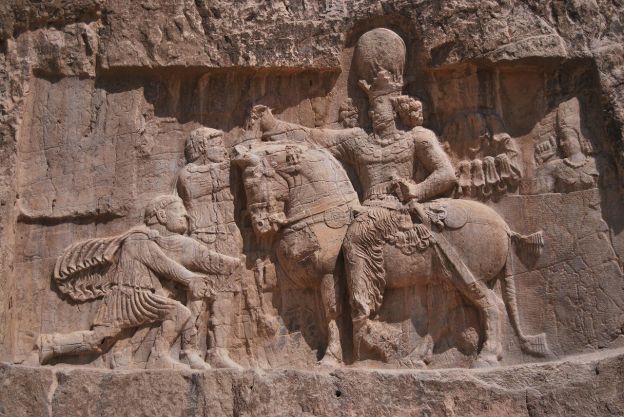
Necropolis of Naqsh-e Rostam, Iran
About fourteen centuries ago, during the Muslim incursion into the Sasanian Empire of Iran, Arabic script was adopted by Persian speakers. Prior to that time, Old Persian cuneiform was the writing system used.
Today, both Farsi and Dari are written in the Arabic-based Persian alphabet. Dari and Farsi words are written and read from right to left.
Tajiki has had several different writing systems, based on events in its own cultural and political history. Prior to Tajikistan’s tenure in the former Soviet Union, Tajiki had been written in the Persian alphabet. For a brief time, between 1928 and 1939, Tajiki was written in the Latin alphabet. Currently, it’s written in the Tajiki Cyrillic alphabet, which is similar to the Russian alphabet.
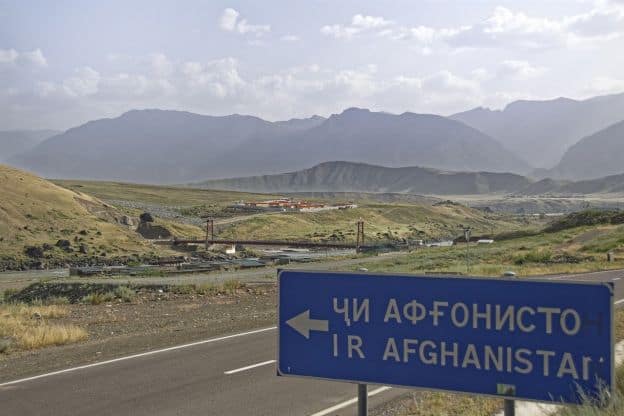
Afghanistan-Tajikistan Border
Bukhori, a dialect of Tajiki Persian spoken by Bukharan Jews, had historically been written in the Hebrew alphabet. (The Bukhori dialect borrows heavily from Hebrew, with a few loanwords from Uzbek, Persian, Russian and Arabic.) These days, however, the Bukhori dialect of the Tajiki Persian standard tends to be written in Cyrillic.
Later on, we’ll look at some resources to help you learn to write and type in Persian, whether in the Perso-Arabic script or Tajiki Persian Cyrillic.
Word Order and Grammar Differences
In Persian, adjectives appear to come after nouns. “Good morning” would be “morning good,” for example.
Even something as simple as “the” or “a” is different in Persian. The definite article — the word for “the” — is not used in written Persian; any noun without an article is understood to have “the” in front of it. On the other hand, Persian does have an indefinite article (a word meaning “a” or “an”).
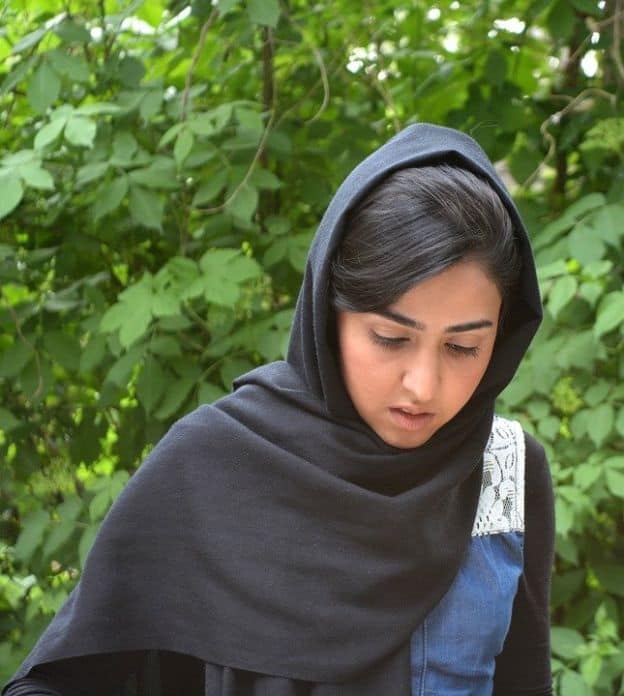
Young woman in Afghanistan
The grammatical rules used in spoken Persian can differ from acceptable grammar in written Persian. Written Persian uses a Subject-Object-Verb (SOV) word order, which is different from English’s Subject-Verb-Object (SVO) word order. In written Persian, a sentence such as “I see him” would be written as “I him see.” In spoken Persian, however, this SOV word order is not followed as strictly. This more flexible characteristic of the language might make it a little easier for English speakers to learn spoken Persian.
Spoken Persian often drops the subject from sentences, since the verb conjugations will clearly tell you who is doing an action.
Formal Address in Persian
As a formal way to directly address a single person, Persian uses شما, the plural word for “you.” This is a convention we no longer have in modern English, since our word “you” is both singular and plural, and we don’t have separate words for formal or informal “you.”
French, Spanish, German, and a number of other languages have a similar convention to Persian. In French, for example, the plural vous (you) is also used as a formal “you” when formally addressing a single person.

Azadi Tower (from below), Tehran, Iran
Especially in Iran, Persian speakers embrace the use of formal titles — in addition to the formal “you” — to show respect to others. These titles can be social, professional, or academic. Unlike in English, titles are often placed after the given name or surname of the person you’re addressing…although there are additional honorifics that may be placed before the person’s name.
What’s the Best Way to Learn Persian?
Consistency is key to learning Persian. You should practice regularly and be patient with yourself as you learn Persian.
Immersing yourself in the language and culture will enhance your learning experience. Surround yourself with the language by changing your devices to Persian, following Persian news, or joining online forums in Persian.
Similarly, using sites such as Tandem and HelloTalk will help you connect with native Persian speakers for language exchange, where you can practice speaking and receive feedback.
What’s the Easiest Way to Learn Persian?
Tailor your approach to your preferred learning methods, and don’t hesitate to experiment with different methods to find what works best for you. The key is to make learning Persian enjoyable and manageable.
Apps like Duolingo, Babbel, and Memrise offer structured lessons that gradually introduce Persian vocabulary and grammar. These apps often incorporate interactive exercises and games.
Persian movies, TV shows, and music are fun ways to pick up vocabulary and pronunciation. This exposure to authentic language use helps you become familiar with the rhythm and intonation of spoken Persian.
Finally, use flashcards to memorize Persian vocabulary wherever you are. Apps like Anki or Quizlet can be helpful for creating digital flashcards.
How Long Does it Take to Learn Persian?
It takes around 1100 hours of study to move from A0 (no Persian skill at all) to an advanced level. If you were to study full-time, it would take you around 44 weeks to gain fluency.
However, there are various factors that will influence the time it takes for you to learn Persian. For example, if your native language is linguistically closer to Persian, you might find it easier to learn certain aspects of the language. For example, speakers of languages with similar structures, such as other Indo-European languages, may have some advantages.
How to Learn Persian Fast?
Learning Persian quickly requires a focused and efficient approach. Make sure you dedicate focused, concentrated time to learning Persian. Short, intense study sessions are often more effective than longer, sporadic ones.
Focus on repetition. Going back over vocabulary might seem like a waste of time when you’re trying to learn quickly, but the science of learning shows us that regular repetition helps solidify what you’ve learned. Use flashcards to reinforce vocabulary and grammar.
Finally, integrate various language skills (listening, speaking, reading, writing) into your study routine. This comprehensive approach enhances overall language proficiency.
How to Speak Farsi?
1. Learn the Persian Alphabet
Persian uses a script called the Perso-Arabic script. Familiarize yourself with the alphabet to be able to read and write in Persian.
2. Master Basic Pronunciation
Practice the pronunciation of individual sounds and learn how to combine them to form words. Pay attention to the unique sounds in Persian that may not exist in your native language.
3. Build Vocabulary
Gradually expand your vocabulary. Start with common words and phrases related to daily life, and then progress to more specific topics of interest or situations.
4. Use Language Apps
Utilize language learning apps that focus on speaking and pronunciation. Some apps offer interactive exercises and speaking challenges.
Your Study Plan for Learning Persian
Now that we’ve gotten to know a little more about the Persian language, let’s take a moment to talk about the best way to learn it.
One of the best ways to learn any language is to make it part of your everyday life, as much as you can. When you first start learning, this might be as simple as spending fifteen minutes a day studying vocab or doing writing exercises.
As you progress, your increasing knowledge will give you opportunities to integrate Persian more into your day-to-day life. Try listening to Persian podcasts or music, reading Persian articles, watching Persian films, or even engaging in conversation with a Persian-speaking partner. We’ll take a look at resources that will allow you to do all of these activities, and more, to bring you from a beginner level of Persian to fluency.
Other considerations for making a learning plan include your long-term goals for using Persian. Do you want to focus on conversational Persian, so you can speak it with friends or relatives? Is Persian mastery important for a business partnership? Do you have plans to travel in Persian-speaking parts of Iran, Afghanistan, Pakistan, or Tajikistan? Or do you long to study classical Persian literature in its original language?

Badakhshan region, Tajikistan
Clarifying your learning goals will help you find your focus. Consider also if there’s a time frame for you to achieve your goals, such as hosting Persian speakers in your home six months from now.
Make a realistic assessment of your daily schedule to figure out when you can fit in regular study time. Even if you try to create a sense of immersion by surrounding yourself with Persian media like TV shows, films, and music, you’ll still need some time for more structured study.
In the same way that setting aside a few dollars a day into a savings account can add up to a substantial nest egg over time, spending just a few minutes a day studying Persian can make a real difference in your mastery of the language. With regular practice, Persian words and phrases — and even grammar — will start to become second nature to you, yielding dividends of fluency.
Finally, try to personalize your Persian learning experience. Look for learning methods and materials that appeal to you. Don’t rule out unconventional learning opportunities, like following Persian social media or following Persian recipes.
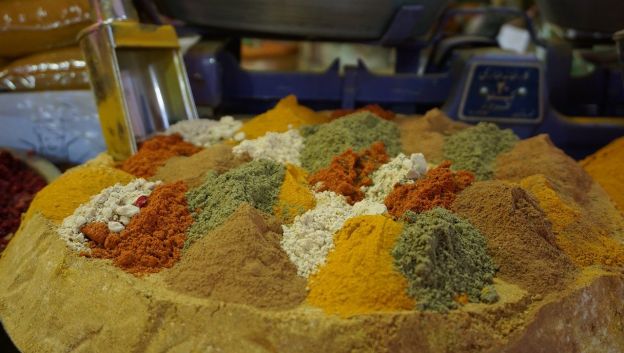
Persian spices
If you’re familiar with your learning style, you can use this information to seek out resources that facilitate your learning. For example, you might find that you learn better when you can look at charts, maps, or pictures that illustrate the concepts you’re studying. On the other hand, you might grasp concepts more quickly by hearing a lecture or listening to an audiobook.
Also, try to find Persian media that ties in with your personal interests and hobbies. It’s enough of a challenge to try reading or listening in an unfamiliar language; if the subject matter doesn’t interest you, you may start to find your studies boring or frustrating. A way to keep your interest high is to treat yourself by sticking to subjects that you thoroughly enjoy.
As you peruse the list of Persian learning resources that follows, keep in mind your goals, learning style, study schedule, and personal preferences.
Don’t be afraid to try new resources and mix up your learning plan from time to time. Even if you’ve designed a plan that centers on your personal interests, you might still find yourself burning out from the same old routine. Using a language learning journal can help you track your learning goals — and it’s also an encouraging record of your progress in Persian.

Tracking Persian learning goals in a language journal
Throw yourself a curveball periodically, taking a break from some of your usual habits and diving into something different. Check out a different musical or cinematic genre. If you would normally read Persian novels, for example, try switching to nonfiction, poetry, or magazines.
Additional Persian Learning Resources
Having supplementary learning resources aside from apps and courses is always a smart idea. Some of these resources could be great ways to help you get more information on the Persian language and understand how it is used in different contexts.
Websites for Learning the Persian Language
With lots of varied information that you can explore at your own pace, websites about the Persian language can guide you through studies of vocabulary, grammar, conversation, literature, and Persian culture.
Farsi
Ali Jahanshiri’s website presents a number of useful resources for Persian learners, such as an online verb conjugator, typing tools, lists of Persian words and phrases by category, and grammar tips. The largest collection of resources is in English, but there are also versions of some resources in Persian, Spanish, French, Italian, and German.
Learn Persian Online offers extensive resources for Farsi learners at all levels, including books, free lessons, and a language and culture blog.
My Persian Corner’s extensive blog has information about learning the Persian language, as well as explorations of Iranian culture and the country itself.

Iranian Chess Set
The University of Texas at Austin hosts Persian Online, a rich resource for grammar instruction, as well as some vocabulary and cultural information. It also includes interactive quizzes, so you can test your knowledge as you go along.
Learn Persian with Chai & Conversation has a blog, a poetry section, and free audio lessons — as well as some paid, members-only content to learn reading, writing, and other skills. There’s also a YouTube channel, with video lessons to help you learn the Farsi Persian standard.
Farsi Wizard is the online home of Tina Rahimi, a professional tutor who gives one-on-one lessons in the Tehranian accent of the Farsi Persian standard. The site hosts tales of a Persian folk hero called Mulla Nasrudin; the stories include Farsi audio and text, an illustration, and a link to the English translations. Farsi Wizard also has its own YouTube channel, with dozens of video lessons about Persian culture, vocabulary, grammar, and writing. For more grammar, vocabulary, and cultural information, Farsi Wizard boasts its own line of ebooks.
The Easy Persian website has an archive of fifty Farsi (Iranian) Persian lessons, which include the alphabet, a bit of vocabulary, and fairly extensive grammar lessons for beginners and intermediate learners.
For those learning the Iranian Persian standard, Transparent Language also hosts a Farsi Language Blog, although there are only a small handful of entries.
Dari
Despite the lack of specific cultural information and grammar lessons in their core curriculum, Transparent Language’s Dari Language Blog includes grammar explanations, vocab discussions, and Afghan cultural explorations. While the blog has been inactive for a few years, there are still many helpful and interesting posts available, written by native speakers.
Tajiki
If you’re learning a bit of Tajiki strictly for travel, the Tajik Phrasebook from Wikitravel will break down the basics. It lacks audio files, but it gives a rough phonetic version for each Tajiki phrase listed.

Tajik woman selling bread
One of the few websites for aspiring Tajiki speakers, Talk Tajik Today has lists of learning resources like dictionaries, flashcards, and grammar guides. It also provides text-based lessons, an extensive word-of-the-day archive, and more.
Books and Literature
Whether in electronic or print form, books are a solid resource for Persian learning and practice. Choose books that cater to your interests and learning needs. Try reading for fun, even if it’s just a short picture book.
Readers
Especially for complete beginners and lower intermediate Persian learners, graded readers offer a structured way to gradually advance Persian reading skills.
For beginners, there’s the Easy Persian Reader: Beginner to Low Intermediate Level: (Farsi-English Bi-lingual Edition) by Nazanin Mirsadeghi, which includes a pronunciation guide for the Persian alphabet. Persian passages are paired with phonetic pronunciations in the Latin alphabet. You can test your reading comprehension with true/false questions, fill-in-the-blank exercises, and other activities.
Other choices of graded Persian readers include A Persian Reader (for first-grade learners), the Persian (Farsi) Second Grade School Reader, and the Persian (Farsi) Third Grade School Readerby Lily Ahi Ayman. According to the description on Amazon.com, these are made for “Iranian-American children,” but could also work well for any intermediate-level Persian learner who doesn’t require English-language glossing of the text.

Reading a Persian-language book
While nowhere near as current as its title would imply, A.J. Arberry’s Modern Persian Reader — first published in 1944 — can still give intermediate learners a solid background and reading practice with newspapers and magazine articles. It includes brief glossaries, as well as some historical and cultural notes.
Tajiki beginners and lower intermediate learners might profit from Tajiki: Thematic Vocabulary and Short Stories, part of the Turkicum Book Series. The text works like a graded reader, with simple short stories grouped by vocabulary themes. There’s also information about Tajikistan and the Tajiki language itself, including some basic grammar points.
Bilingual Children’s Books
For very basic, beginner’s concepts, Milet Publishing has made several dozen bilingual books available on topics such as music, sports, and household vocabulary. You can find many of these on Amazon.
KidKiddos Books, a publisher of bilingual children’s books, comes through for Persian learners with a double handful of ebooks and printed books. Several of these are also available through Amazon.com.
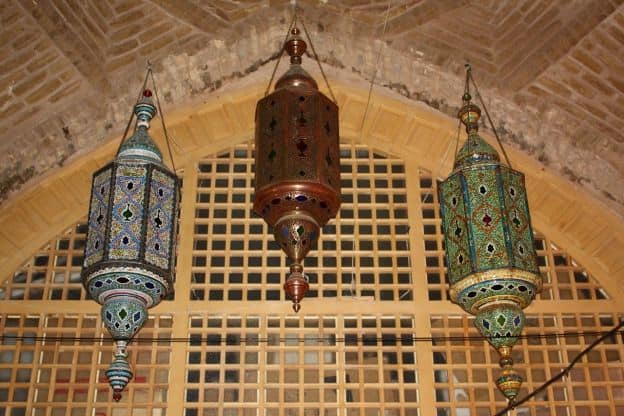
Lamps in the Mosque, Isfahan, Iran
Other Persian children’s books to check out include Yalda Night by Anahita Tamaddon, My Mother's Persian Stories: Folk Tales for All Ages in English and Farsi by Saeid Shammass, Am I small? آیا من کوچک هستم؟: English-Dari/Afghan Persian/Farsi by Philipp Winterberg et al., and Mana and the City of Stars by Nazanin Mirsadeghi.
Get out your colored pencils and crayons to enjoy Egbert Turns Red/Эгберт сурх шуд, an English-Tajiki coloring book that provides reading practice for beginning Tajiki learners. For learning without coloring, try the Tajiki version of Winterberg’s Am I small? Оё ман хурд астам?.
Textbooks
Textbooks and grammar books can give you guidance to learn the rules and structure of Persian in a methodical and comprehensive way.
Farsi
Farsi (Persian) for Beginners: Mastering Conversational Farsi by Dr. Saeid Atoofi is primarily for learning conversational Persian, although it covers the alphabet over the course of the text. The chapters are arranged according to topical vocabulary, like seasons of the year, greetings, phone calls, emotions, and dining. The book teaches both formal and informal Persian, highlighting the differences between the written and spoken language. There are a few grammar points in each themed chapter, as well.
Farsi Grammar in Use: For Beginners by Gholamreza Nazari starts with the Persian alphabet and moves on to simple verb conjugations and question words.For intermediate-level learners, Basic Persian: A Grammar and Workbook by Saeed Yousef and Hayedeh Torabi goes into depth about Persian grammar, with examples and exceptions to grammar rules. It’s more expensive than most books, but can be rented monthly — for a much lower price — as an Amazon Kindle ebook.
Dari
A Learner’s Grammar of Dari is available online as a free PDF from International Assistance Mission. It not only covers parts of speech and guidelines for using them, but also gives you an overview of the language and its pronunciation. It’s a fairly recent work, with a 2017 publication date.

Traffic circle, Kabul, Afghanistan
If you’d prefer a paperback, Amazon stocks Learn Dari: Your First Dari Words, Conversation, Reading and Writing, Grammar, and Vocabulary by Sayed Naqibullah.
Tajiki
Historically, printed resources for English-speaking learners of the Tajiki Persian standard have been sparse — and expensive for readers. Fortunately, there are a few more reasonably priced options now available.
A Basic Course in Tajik (Grammar & Workbook), by Randall B. Olson, is available in PDF form from the Talk Tajik Today website. Some of it may be a bit outdated, as the text had originally been published in 1994. However, it provides a solid and detailed introduction to Tajiki phonetics, grammar, and foundational vocabulary.
You can read A Beginner’s Guide to Tajiki by Azim Baizoyev and John Hayward online, or download it as a PDF. Published in 2004, this slim, public-domain volume will take you systematically through Tajiki grammar and other fundamentals. (If you’d prefer to purchase it as a print book or ebook in the Kindle format, it’s available through Amazon.)
Tajik Language: The Tajik Phrasebook by Gulshan Ibragimova provides basic Tajiki phrases with English translations and phonetic pronunciations. Tajiki: Real-Life Conversations for Beginners is not a textbook in the strict sense. However, it can help learners become more comfortable with everyday, spoken Tajiki. The book includes a brief history of the region, its people, and the Tajiki standard of Persian. Tajiki Reference Grammar for Beginners by Nasrullo Khojayori can add some structure to your Tajiki studies. It also includes pronunciation information and examples to illustrate the grammar rules.
Khojayori also wrote Tajiki: An Elementary Textbook, which is somewhat expensive — and might work better in a classroom setting than for self-guided learners, as some of the words in the dialogues are not glossed. The textbook was published in two volumes in May 2009 by Georgetown University Press, and is accompanied by Tajiki audio and video material on a CD-ROM.
Eton Institute’s Tajiki Phrasebook is available at a low price from Apple Books. It lacks grammar but includes common phrases and idioms, as well as cultural information. It might be particularly useful for tourists in Tajikistan.
Persian Literature
Persian literature is available for all standards of the language, but most abundantly for the Iranian Farsi standard.
Farsi
Sources for Farsi books include Karoon (search by Language: Farsi), iranibook, ShopiPersia, and, of course, Amazon.
Dari
Dari learners can find reading practice through the Afghan Bookshop. A Dari translation of the Christian Bible is available on the Afghan Bibles website.
There are a few Dari books on Amazon, as well: Zarbul Masalha: 151 Afghan Dari Proverbs by Edward Zellem (edited by Aziz Royesh) can give you a taste of the language and culture in short snippets. Amazon also offers The Wisdom of Ahmad Shah: An Afghan Legend: English-Dari Edition (Hoopoe Teaching-Stories) by Palwasha Bazger Salam.
Tajiki
For more advanced Tajiki learners, the Internet Archive comes to the rescue with an online collection of Tajiki books, downloadable as RAR files or torrents.
Poetry
A Book of Verses underneath the Bough,
A Jug of Wine, a Loaf of Bread — and Thou
Beside me…
These verses, well-known in the English language, are from Edward FitzGerald’s famous 19th century translation of a legendary Persian poem: The Rubáiyát of Omar Khayyám. While there is some speculation that perhaps Khayyám did not pen all of the quatrains in the Rubáiyát, there is no doubt that poetry plays an important role in Persian language and culture.
It has been said that Shahnameh (The Book of Kings), an epic poem that’s revered in Iranian-influenced cultures, made such an impact that the Persian language has barely changed since Shahnameh was written, over one thousand years ago. Persian speakers today would presumably understand Shahnameh fairly easily, based on their fluency in Modern Persian.

Music Hall, Grand Ālī Qāpū, Isfahran, Iran
By way of comparison, imagine if a 21st century English speaker could pick up a copy of Beowulf in its original Old English form, and read it without any glossing or translation. This would be fairly extraordinary. After all, most Modern English speakers struggle a bit with Shakespeare, who wrote in Early Modern English!
Ancient Persian poetry is still very much appreciated, and has inspired modern Persian poets to continue the proud tradition. Bilingual books of Persian poetry are a fantastic way for intermediate and advanced learners to delve into metaphor and symbolic language. Some of these volumes are not fully bilingual, but offer guidance and insights on interpreting Persian poetry:
- Persian Sugar in English Tea: A Bilingual Anthology of Short Poems and Haikus
- Persian Sugar in English Tea (Volume II): A Bilingual Anthology Short Poems and Haikus
- Bring Me a Lamp (An Anthology of Poems by Modern Iranian Poets): (Bilingual English/Persian Edition)
- The Gulistan (Rose Garden) of Sa'di: Bilingual English and Persian Edition with Vocabulary
- Faces of Love: Hafez and the Poets of Shiraz: Bilingual Edition
- Say Nothing: Poems of Jalal al-Din Rumi in Persian and English (English and Farsi Edition)
- Selected Poems from the Divan-e Shams-e Tabrizi
- A Millennium of Classical Persian Poetry: A Guide to the Reading and Understanding of Persian Poetry from the Tenth to the Twentieth Century, by Wheeler M. Thackston
- The Pearl of Dari: Poetry and Personhood among Young Afghans in Iran by Zuzanna Olszewska
News and Magazines in Persian
Intermediate and advanced learners who like keeping up with all the latest news might consider getting some of their coverage in Persian. It’s a great way to learn contemporary vocabulary in a broad range of topics, all while absorbing cultural, political, and historical knowledge about the countries where Persian is spoken.
Afghanistan has two major Dari news sources; one is the government-run Baktar News Agency; the other is پژواک خبري اژانس , آژانس خبرى پژواک (the Pajhwok Afghan News), an independent media source established in 2003.

Kabul street scene, Afghanistan
Iran has numerous Farsi Persian news sources, although a few of them are currently banned. If you prefer sports news to hard-hitting political fare, Khabar Varzeshi will give you all the latest on Iran’s football (soccer) clubs, including news about شهرآورد تهران (Shahrāvard-e Tehrān, the Tehran Derby). Some learners might expand their Farsi-learning horizons to the farthest star with سفید, a speculative fiction annual based in Tehran.
Elsewhere in the world, BBC News has a Persian site that covers international news, especially stories from Iran and Afghanistan. Canada’s ایران استار (Iran Star) is a reliable news source for the Persian speakers in North America. The Persian community in the United States also publishes many Farsi periodicals, such as Ferdosi Emrooz (Encino, California), Asheghaneh (Houston, Texas), and Iranians Newspaper Weekly (Washington, D.C.).
Learners of the Tajiki Persian standard can enjoy native news from several sources:
- Ховар (Khovar, “East”)
- Фараж (Faraj)
- Ҷумҳурият (Jumhuriyat, “Republic”; government-owned)
- Тоҷикстон (“Tajikistan”; privately owned)
- Садои Мардум (Sadoi Mardum, “The Voice of the People”)
Music
Whether traditional folk, contemporary pop, rap, jazz, or rock, there’s bound to be Persian music that fits your groove and propels your Persian studies forward.
The repetition of the music and lyrics will help you remember Persian words as it exposes you to Persian pronunciations. To bolster your understanding of grammar and sentence structure, as well as your mastery of grammar, try translating the lyrics of your favorite Persian songs.
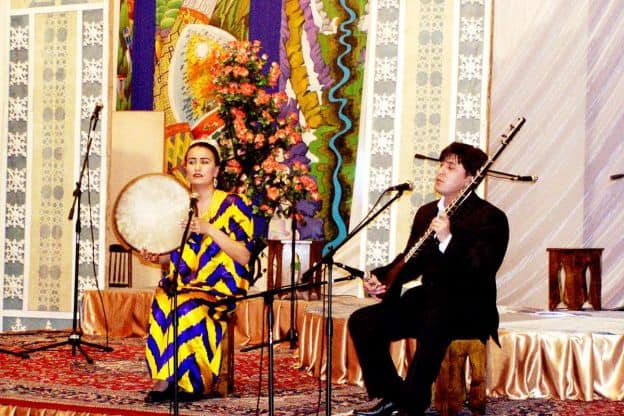
Tajik folk performers, Nasiba Omonboyeva and Kamoliddin Khamdamov
There are dozens of Persian artists to explore; you may be pleasantly surprised to find an Afghan, Iranian, or Tajiki artist performing in a style you love — and you’re likely to discover many new songs to add to your playlists. Here are but a few notable singers to check out:
- Widely considered the greatest Afghan singer of all time, احمد ظاهر (Ahmad Zahir) was a legendary Dari Persian artist. His powerful, expressive voice can be enjoyed through many tribute videos on YouTube.
- Popular Tajik folk singer Нигина Амонқулова (Nigina Amonkulova) is a regular guest on Tajikistan’s state-run television channels. Her official music videos are readily available on YouTube. Nigina’s style mixes some pop music influences with traditional musical patterns and instruments.
- Tehran native فائقه آتشین (Faegheh Atashin), better known to the world as گوگوش (Googoosh), had been a renowned singer, film star, and style icon until 1979’s Iranian Revolution. She spent the next two decades in her native Iran, where — as a female singer — she was forbidden to perform. Googoosh left Iran in 2000. Since then, she’s been bringing her music to eager audiences throughout the world.
To sample a variety of contemporary Persian music, try YouTube channels like TPM – Top Persian Music, Persian Music Group, PMC – PERSIAN MEDIA CORPORATION, and Persian Music.
Based in the United States, the RadioJavan site offers a wide variety of Farsi fare, including streaming music MP3s, playlists, and music videos.

Qom, Iran
You can find several Tajik music channels on YouTube, although some of the selections may not be in Tajiki Persian.
YouTube can also introduce you to Dari Persian music in a variety of styles.
Radio, Television, and Films
Keep your eyes and ears open to Persian learning by engaging with the language in multimedia such as radio, TV, and movies.
Radio
Persian radio stations from around the world are widely available through online streaming, although not all stations will stream in all regions.
Sources for streaming Persian stations include Radio Online Live, which gives you access to dozens of radio broadcasts from Iran and Afghanistan. (Radio stations from Tajikistan don’t seem to be available at this time.)
TuneIn provides a similar service, with streaming portals for Afghan radio stations, Iranian radio and television, and a few stations from Tajikistan. (Since these lists are location-based, there may be some broadcasts and music in other languages besides Persian.)
Sedaye Iran is a solid source for Farsi Persian radio. Based in Alfter, Germany, the site is a streaming portal for numerous Farsi news and music stations. Some of these are broadcast from Iran; others come from Los Angeles and other locations.

Houses at Karakul, Tajikistan
Radio Free Europe’s Tajik Service hosts several Tajiki-language radio programs online, with topics ranging from news to economics to sports.
Television and Films
The two primary ways to access Persian television and movies are streaming online or through your cable or satellite provider.
Many media outlets make programming available through their YouTube channels, which you can often watch on a regular television through a streaming device like Roku, Apple TV, Fire TV, or Chromecast. Some gaming consoles, such as the Xbox and PlayStation, also support this feature.

Accessing Persian TV and films with a streaming device
Persian TV and Movies on YouTube
For free access to Persian programming, check out YouTube channels like تلویزیون آریا (ARIA TV Canada), pan-Persian Iran TV (which features videos about Afghanistan and Tajikistan, in addition to Iran), and Iran TV Network (which primarily shows interviews, talk shows, and entertainment coverage, focused on Persian communities around the world).
Toot is an Afghan YouTube channel with similar cultural and entertainment content to Iran TV Network.
ايران اينترنشنال (Iran International) has pioneered round-the-clock news coverage in Persian. You can also watch the London-based channel over your satellite connection, as the outlet has provided all the technical specs needed to tune in from locations around the world.
The BBC Persian YouTube channel is a treasure-trove with thousands of high-quality Persian-language videos. It will take you all around the world and give you insights on history, culture, and current events.
Web-Based Streaming
A few media companies feature multi-channel portals with access to stream Persian channels through your internet browser. Sedaye Iran, for example, has an Iran Live TV page.
RadioJavan hosts its own television platform, with both live and on-demand TV. Try the quirky Gringo Show, or late-night talk show Chand Shanbeh. Music fans can see their favorite artists interviewed on hip entertainment program Spot. Avid video gamers might particularly enjoy the discussions, demos, and interviews on Joystick.
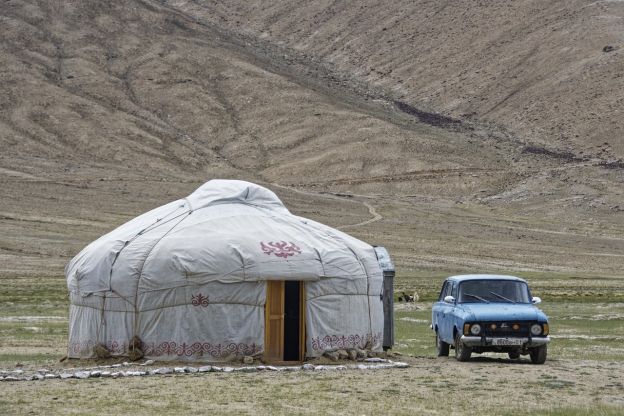
A yurt in Tajikistan, as seen in the Pamir Mountains
Satellite TV Options
At this writing, major satellite TV providers like AT&T/DirecTV and DISH Network are not offering Persian programming packages among their international options. However, you may be able to tune into a few select channels. Like Iran International and RadioJavan TV, the aforementioned Iran TV Network — which is based in California — lists its satellite reception information on its website.
Streaming Devices and Services
Through your preferred streaming device, you might have access to some of these Persian-language networks and channels. These include networks such as JadooTV’s Persian channels, which broadcasts the Pars TV, RadioJavan, Manoto HD +, and Omid Iran channels, among others.
If you have a Roku device, you have several options for Persian language programming, available via Roku’s Channel Store:
- Jadoo TV Farsi
- Tamashakhane Persian TV
- Tajikistan TV
- Iran TV
- IRAN HD ICC Rubico (500 pre-Revolution Iranian movies)
- Afghan TV Procast
With any streaming device or service, channel availability can depend on your region, and additional monthly fees may apply.
Available programming for streaming services such as Netflix changes over time, and often depends on the region where you’re watching it. Most of these services have a search feature where you can look for programming in your target variety of Persian.
If you can make media like Persian TV shows and movies a regular part of your learning routine, you’ll have an entertaining source of authentic media that teaches you more than just Persian vocab and grammar — it can give you a window into contemporary Persian culture.

Outskirts of Tehran, Iran
As you weave together your own personal tapestry of learning, you’ll find yourself on the path to Persian-language paradise. This journey will open up your world and enrich it.
As celebrated 13th-century Persian poet جلالالدین محمد رومی (Jalāl ad-Dīn Muhammad Rūmī) said in his poem, “If a Tree Could Wander”:
Out of yourself ? such a journey
will lead you to your self,
It leads to transformation
of dust into pure gold!
Enjoy the journey.
Related Posts
If you found this article useful, you might also like:

